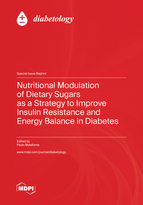Nutritional Modulation of Dietary Sugars as a Strategy to Improve Insulin Resistance and Energy Balance in Diabetes
A special issue of Diabetology (ISSN 2673-4540).
Deadline for manuscript submissions: closed (30 September 2022) | Viewed by 41000
Special Issue Editor
Interests: glycation; insulin sensitivity; gut hormones; diabetic vascular complications
Special Issues, Collections and Topics in MDPI journals
Special Issue Information
Dear Colleagues,
Lifestyle changes towards less healthy behaviours with the increased consumption of westernised diets and processed food is associated with the increasing prevalence of overweight in young adults and risk for obesity and associated pathologies later in life. The World Health Organization (WHO) established guidelines for free sugar intake in adults and children below 5–10% of the total daily energy, but recent studies support that it may be 15–20% in adults. The consumption of added sugars contributes to an increased energy density of the diet, leading to a positive energy balance, higher waist circumference, and weight gain, increasing the risk of obesity and type 2 diabetes.
Sugars may be divided into two distinct groups: those naturally present and those added to foods. Natural or intrinsic sugars are naturally present in foods, such as fruit sugar (fructose), vegetables, honey, and sugars from dairy products (galactose and lactose). The added sugars are a large group of mono- and di-saccharides added to foods during processing, preparation, or at the table, with the objective of sweetening and increasing food palatability and shelf life, improving texture, inhibiting growth microorganisms in high concentrations, giving functional structures, or offering more accessibility. They are mostly found in sugary drinks, pastry products, cookies, fruit juices, energy drinks, nectars, fruit juices, concentrated fruit, white bread, and breakfast cereals.
The impact of dietary sugars on the pathophysiological mechanisms of type 2 diabetes and its complications is not entirely understood. This Special Issue will explore the association between the excessive consumption of dietary sugars, their sources and types, as well as their different impact in several features of type 2 diabetes aetiology and mechanisms of disease
Prof. Dr. Paulo Matafome
Guest Editor
Manuscript Submission Information
Manuscripts should be submitted online at www.mdpi.com by registering and logging in to this website. Once you are registered, click here to go to the submission form. Manuscripts can be submitted until the deadline. All submissions that pass pre-check are peer-reviewed. Accepted papers will be published continuously in the journal (as soon as accepted) and will be listed together on the special issue website. Research articles, review articles as well as short communications are invited. For planned papers, a title and short abstract (about 100 words) can be sent to the Editorial Office for announcement on this website.
Submitted manuscripts should not have been published previously, nor be under consideration for publication elsewhere (except conference proceedings papers). All manuscripts are thoroughly refereed through a single-blind peer-review process. A guide for authors and other relevant information for submission of manuscripts is available on the Instructions for Authors page. Diabetology is an international peer-reviewed open access quarterly journal published by MDPI.
Please visit the Instructions for Authors page before submitting a manuscript. The Article Processing Charge (APC) for publication in this open access journal is 1200 CHF (Swiss Francs). Submitted papers should be well formatted and use good English. Authors may use MDPI's English editing service prior to publication or during author revisions.
Keywords
- T2D
- sugar consumption
- western diet
- obesity
- metabolic syndrome
- etiology
- mechanisms






